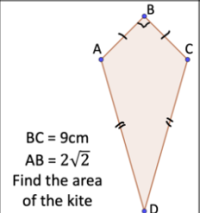maths1996l
New member
- Joined
- Jul 1, 2024
- Messages
- 1
View attachment 38264
Does the line segment AB need to be changed to AD?
BC and AB should be the same length?

Hi. No, but their label BC needs to be changed to AD. Use these lengths:Does the line segment AB need to be changed to AD?
If [imath]AB = BC[/imath] and [imath]AD = CD[/imath], I think that Otis method by dividing the kite into four right triangles is the quickest way to find the area of the kite. But I have another idea which is more fun and it does not matter what is the length of each leg as long as you know the lengths of all legs. Draw a segment [imath]AC[/imath] and find the length of this segment, then you will have two triangles, each with three known legs. Use this formula to find the area of each triangle. I will prepare it for the smaller triangle:View attachment 38264
Does the line segment AB need to be changed to AD?
BC and AB should be the same length?
